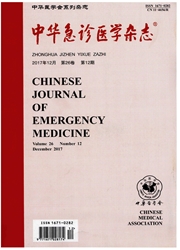

 中文摘要:
中文摘要:
BACKGROUND: Partial pressure of end-tidal carbon dioxide(PETCO2) has been used to monitor the effectiveness of precordial compression(PC) and regarded as a prognostic value of outcomes in cardiopulmonary resuscitation(CPR). This study was to investigate changes of PETCO2 during CPR in rats with ventricular fi brillation(VF) versus asphyxial cardiac arrest.METHODS: Sixty-two male Sprague-Dawley(SD) rats were randomly divided into an asphyxial group(n=32) and a VF group(n=30). PETCO2 was measured during CPR from a 6-minute period of VF or asphyxial cardiac arrest.RESULTS: The initial values of PETCO2 immediately after PC in the VF group were signifi cantly lower than those in the asphyxial group(12.8±4.87 mmHg vs. 49.2±8.13 mmHg, P=0.000). In the VF group, the values of PETCO2 after 6 minutes of PC were significantly higher in rats with return of spontaneous circulation(ROSC), compared with those in rats without ROSC(16.5±3.07 mmHg vs. 13.2±2.62 mmHg, P=0.004). In the asphyxial group, the values of PETCO2 after 2 minutes of PC in rats with ROSC were signifi cantly higher than those in rats without ROSC(20.8±3.24 mmHg vs. 13.9±1.50 mmHg, P=0.000). Receiver operator characteristic(ROC) curves of PETCO2 showed signifi cant sensitivity and specifi city for predicting ROSC in VF versus asphyxial cardiac arrest.CONCLUSIONS: The initial values of PETCO2 immediately after CPR may be helpful in differentiating the causes of cardiac arrest. Changes of PETCO2 during CPR can predict outcomes of CPR.
 同期刊论文项目
同期刊论文项目
 同项目期刊论文
同项目期刊论文
 期刊信息
期刊信息
